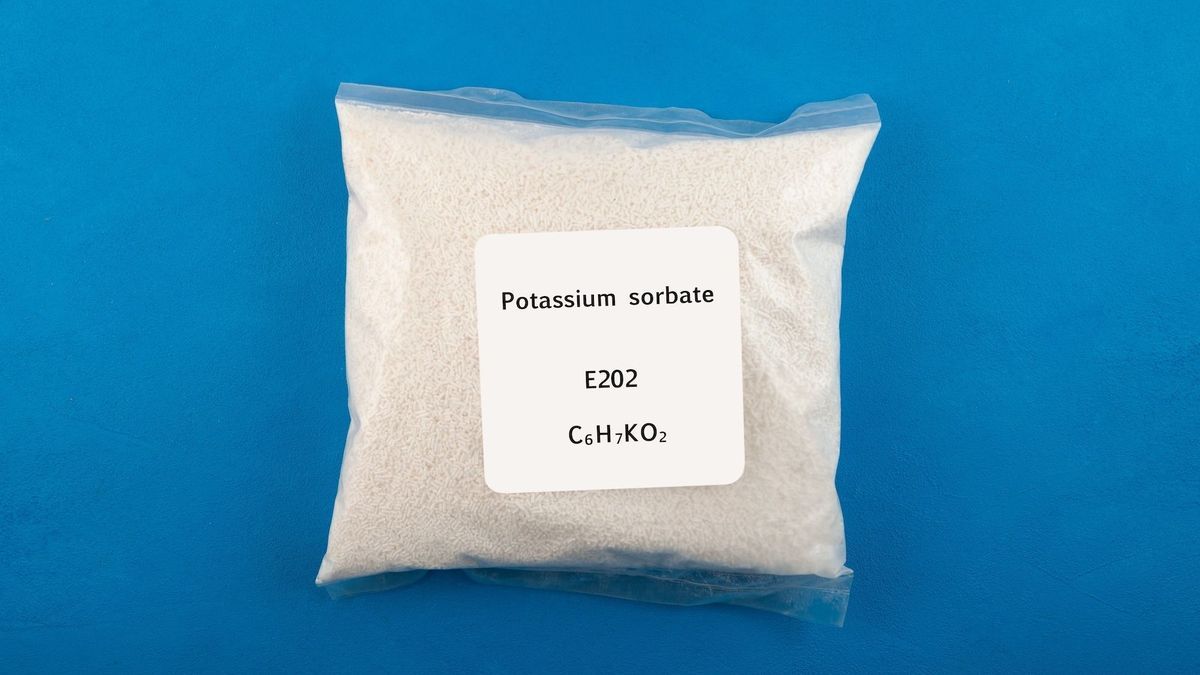
This food additive is a preservative present in many commonly consumed foods. In what food products can we find it? What are the roles of this additive? Is it dangerous for health? We take stock.
What is the preservative E 202?
Also called “potassium sorbate”, it is a food additive of plant origin, present naturally in the immature berries of the mountain ash (a small tree) or in the fruits of the ash tree. But that which is used in the food industry is chemically synthesized from sorbic acid (E 200) and potassium hydroxide. “The additive E 202 is therefore a potassium salt of sorbic acid. This additive is mentioned as a preservative in the Codex Alimentarius. It comes in the form of small white granules or a fine white powder, odorless, soluble in water and fats. explains Jimmy Thai, expert on food additive issues and author of the site www.docteur-fitness.com
Is the food additive E202 authorized in Europe and what are its uses?
Authorized in Europe, it is used by the food industry as a preservative, thanks to its antibacterial, antimicrobial and antifungal properties. “It reduces the development and proliferation of bacteria and yeasts, it is particularly effective in inhibiting the development of molds such as Aspergillus, Penicillium and yeasts such as Saccharomyces., specifies Jimmy Thai. Thus, it makes it possible to extend the shelf life of food, it contributes to the preservation of the organoleptic quality and to facilitate the storage of food. It does not add any taste or odor to food, and does not modify its texture.
“It is also present in the composition of tobacco, medicines and cosmetic products or even toothpastes, in which it serves as a stabilizer for formulas in the aqueous phase.“, adds our expert.
How does the preservative E 202 work?
“Potassium sorbate exerts its antimicrobial effect by several mechanisms which are not fully elucidated., specifies our expert. It seems to act at different levels on micro-organisms:
· Inhibition of essential cellular enzymes;
· Disruption of the plasma membrane;
· Inhibition of active nutrient transport;
Its effectiveness also depends on several parameters:
· pH: its activity increases when the pH decreases;
· Concentration: its effect increases with concentration;
· Temperature: its effect strengthens when the temperature increases;
· The composition of the food: interaction with other compounds.
“It is often combined with other preservatives such as nitrites or benzoic acid in a synergistic approach to the mechanisms of action. Research is underway to optimize these combinations in order to reduce the doses used.adds Jimmy Thai.
In what foods can you find potassium sorbate?
Potassium sorbate is present in many common foods. Among which :
- Dairy products such as certain cheeses (notably matured, pre-packaged sliced and melted cheeses), natural yogurts and fruit yogurts;
- Potato products such as gnocchi and mash;
- Bread products;
- Instant soups;
- Low-fat butters and margarines;
- Certain cold cuts or processed meats;
- Confectionery, chewing gum, pastries, industrial cakes, jams, jellies and even marmalades;
- Sauces and seasonings such as ketchup, mustard or mayonnaise;
- Certain prepared meals;
- Certain alcoholic beverages;
- Some sodas.
Is it present in organic foods?
This additive is not authorized in food products from organic farming. But it should be noted that it is authorized in organic cosmetics.
Is potassium sorbate suitable for all diets?
This additive is compatible with many diets. It can be consumed by everyone, without fearing for their health or their beliefs.
Is E202 compatible with vegetarian, vegan and vegetarian diets?
Oui.
Is E202 compatible with halal diets?
Oui
Is E202 compatible with kosher diets?
Oui
Is E202 compatible with a gluten-free diet?
Oui
Is there an Acceptable Daily Intake for consuming E 202?
Yes. Initially, the ADI was set in 1996 at 25 mg/kg bw (kilos of body weight)/day. But due to data on the toxicity of sorbic acid on fertility, the EFSA (European Food Safety Agency) has drastically reduced the ADI to 3 mg/kg bw/day for E 200 and E 202.
Is potassium sorbate dangerous for your health?
According to several studies, this additive is described as being of “moderate toxicity”. In other words, consumed at the acceptable daily intake (ADI), it would be safe for human health. The risks of exceeding this dose are quite low because as an additive, the doses used in foods remain very limited.
Does E202 cause allergies?
However, contact with pure E 202 could cause allergies and cause irritation to the skin, eyes and respiratory tract. Thus, in cosmetics, its presence could cause reactions. Oral consumption of sorbic acid could also be responsible for allergies, but this effect is very rare.
Does E 202 cause cancer?
No carcinogenic effect has been demonstrated from the consumption of the additive E 202.
Is E202 responsible for genetic mutations?
A controversy has long followed E 202: in association with nitrites, the additive was suspected of being the cause of genetic mutations, responsible for certain hereditary damage. However, in its opinion on the classification of potassium sorbate, the European Chemicals Agency (ECHA)1 concluded that this substance had shown no genotoxic potential, following tests carried out in vitro and in vivo on rats and mice. This opinion was confirmed by EFSA during its re-evaluation of this additive.
However, as a precautionary principle, and in case of sensitivity, it is recommended to limit the consumption of foods that contain it.
NO to diets, YES to WW!
How to identify the presence of this additive in a food?
You just need to look at the list of ingredients that make up the food product: this additive is hidden under the code E 202 or the name potassium sorbate.
